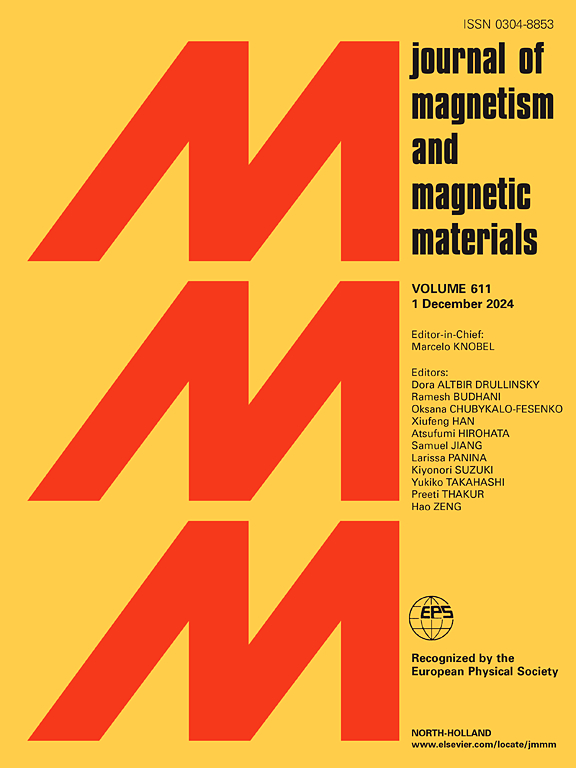Machine learning prediction of magnetic property of lanthanum substituted bismuth ferrite multiferroic with experimental validation
IF 2.5
3区 材料科学
Q3 MATERIALS SCIENCE, MULTIDISCIPLINARY
引用次数: 0
Abstract
Finding new Rare Earth Elements (REE) substituted Bi1-xLaxFeO3 [x = 0.0, 0.03, 0.06] multiferroics with improved performance remains a significant challenge due to the time-consuming nature of conventional trial-and-error approaches and the vast unexplored composition space. Our study introduces a machine learning (ML) approach, explicitly employing a Random Forest (RF) regressor to accurately predict the magnetization (Ms) of REE-substituted multiferroics. Three compositions of Bi1-xLaxFeO3 (x = 0.0, 0.03, 0.06) were synthesized and experimentally characterized to validate the model’s predictions. The RF model was applied to predict the magnetization of Bi1-xLaxFeO3[x = 0.0, 0.03, 0.06], a material system relevant to multiferroic research. In addition, the trained model was tested on literature-reported compositions with other REE substitutions to assess its generalization capability. The model’s predictions showed strong agreement with experimental data, demonstrating strong alignment and confirming its predictive reliability. The model achieved a high coefficient of determination (R2) of 0.99 and the average error of 0.20 emu/g, indicating excellent predictive performance. This work provides a robust method for predicting Ms and paves the way for more efficient design and discovery of REE-substituted multiferroics through data-driven approaches.
镧取代铋铁氧体多铁氧体磁性能的机器学习预测与实验验证
寻找新的稀土元素(REE)取代Bi1-xLaxFeO3 [x = 0.0, 0.03, 0.06]的多铁质材料仍然是一个重大的挑战,因为传统的试错方法非常耗时,而且尚未开发的成分空间很大。我们的研究引入了一种机器学习(ML)方法,明确地使用随机森林(RF)回归量来准确预测ree取代的多铁质的磁化强度(Ms)。合成了Bi1-xLaxFeO3的三种组分(x = 0.0, 0.03, 0.06),并对其进行了实验表征,以验证模型的预测。利用RF模型预测了Bi1-xLaxFeO3的磁化强度[x = 0.0, 0.03, 0.06],这是一种与多铁性研究相关的材料体系。此外,对训练好的模型进行了文献报道的含有其他稀土元素替换的成分的测试,以评估其泛化能力。该模型的预测结果与实验数据非常吻合,显示出很强的一致性,并证实了其预测的可靠性。模型的决定系数(R2)为0.99,平均误差为0.20 emu/g,具有较好的预测效果。这项工作为预测Ms提供了一种强大的方法,并通过数据驱动的方法为更有效地设计和发现ree取代的多铁质材料铺平了道路。
本文章由计算机程序翻译,如有差异,请以英文原文为准。
求助全文
约1分钟内获得全文
求助全文
来源期刊

Journal of Magnetism and Magnetic Materials
物理-材料科学:综合
CiteScore
5.30
自引率
11.10%
发文量
1149
审稿时长
59 days
期刊介绍:
The Journal of Magnetism and Magnetic Materials provides an important forum for the disclosure and discussion of original contributions covering the whole spectrum of topics, from basic magnetism to the technology and applications of magnetic materials. The journal encourages greater interaction between the basic and applied sub-disciplines of magnetism with comprehensive review articles, in addition to full-length contributions. In addition, other categories of contributions are welcome, including Critical Focused issues, Current Perspectives and Outreach to the General Public.
Main Categories:
Full-length articles:
Technically original research documents that report results of value to the communities that comprise the journal audience. The link between chemical, structural and microstructural properties on the one hand and magnetic properties on the other hand are encouraged.
In addition to general topics covering all areas of magnetism and magnetic materials, the full-length articles also include three sub-sections, focusing on Nanomagnetism, Spintronics and Applications.
The sub-section on Nanomagnetism contains articles on magnetic nanoparticles, nanowires, thin films, 2D materials and other nanoscale magnetic materials and their applications.
The sub-section on Spintronics contains articles on magnetoresistance, magnetoimpedance, magneto-optical phenomena, Micro-Electro-Mechanical Systems (MEMS), and other topics related to spin current control and magneto-transport phenomena. The sub-section on Applications display papers that focus on applications of magnetic materials. The applications need to show a connection to magnetism.
Review articles:
Review articles organize, clarify, and summarize existing major works in the areas covered by the Journal and provide comprehensive citations to the full spectrum of relevant literature.
 求助内容:
求助内容: 应助结果提醒方式:
应助结果提醒方式:


